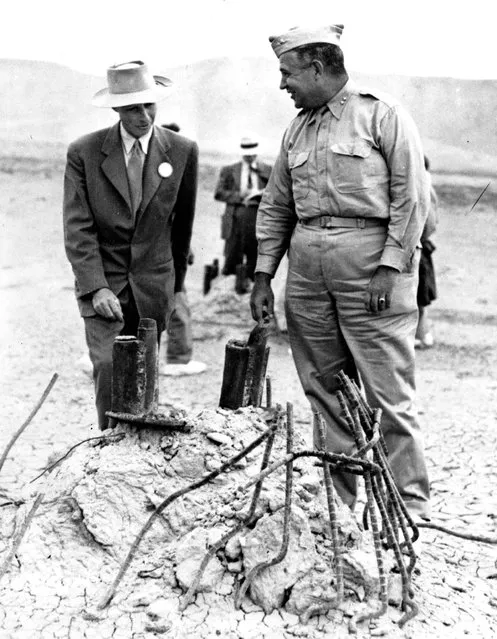
This September 9, 1945, file photo Gen. Leslie R. Groves, right, and Dr. J. Robert Oppenheimer, who cooperated on the development of the atomic bomb, survey the area in Alamogordo, N.M., where a tower once stood before the test bomb exploded. A new PBS special looks into the creation of the atomic bomb in the city of Los Alamos and will feature newly-restored footage of nuclear weaponry. “The Bomb”, which begins airing Tuesday, July 28, 2015, on most PBS stations, seeks to tell the story of the deadly device as the 70th anniversary of the atomic bombings of Hiroshima and Nagasaki approaches. (Photo by AP Photo)
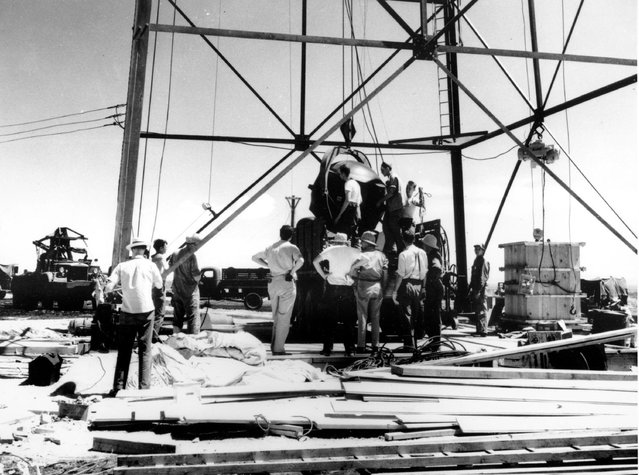
In this July 1945, file photo, scientists and workmen rig the world's first atomic bomb to raise it up into a 100-foot tower at the Trinity bomb test site in the desert near Alamagordo, N.M. (Photo by AP Photo)
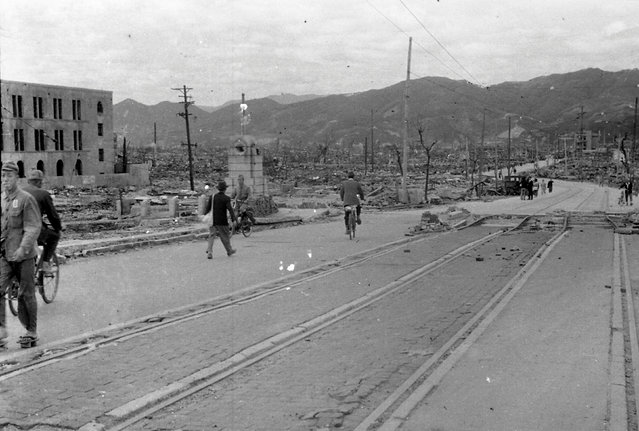
People walk past destroyed buildings at Aioi Bridge in Hiroshima, after the atomic bombing of Hiroshima, Japan, on August 6, 1945, in this handout photo taken by Shigeo Hayashi in October 1945 and released by the Hiroshima Peace Memorial Museum. (Photo by Shigeo Hayashi/Reuters/Hiroshima Peace Memorial Museum)
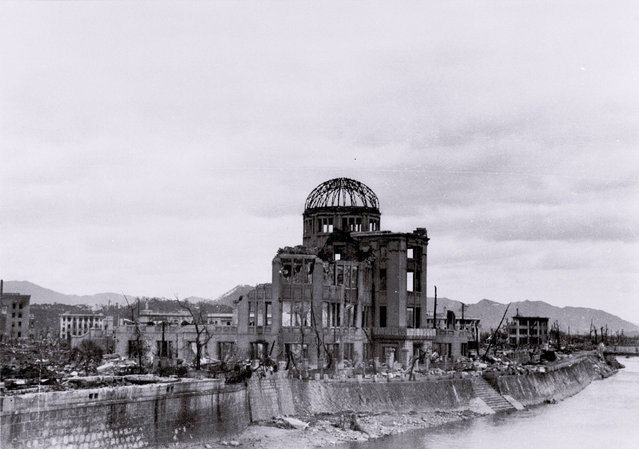
The gutted Hiroshima Prefectural Industrial Promotion Hall (C), currently known as Atomic Bomb Dome or A-Bomb Dome, is seen near Aioi Bridge in Hiroshima after the atomic bombing of Hiroshima, Japan, on August 6, 1945, in this undated handout photo taken by Toshio Kawahara and released by his grandchild Yoshio Kawamoto. (Photo by Toshio Kawamoto/Yoshio Kawamoto/Reuters)
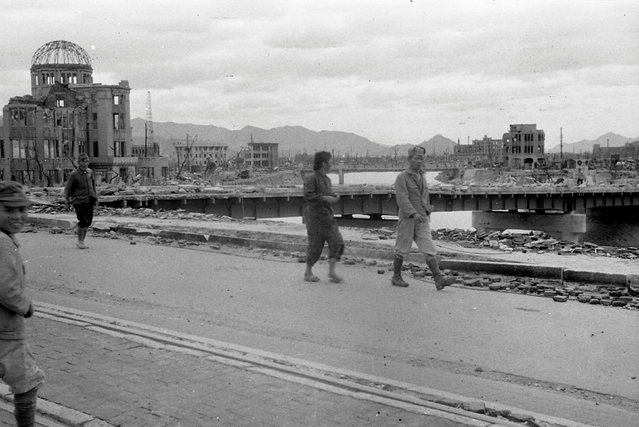
People walk over Aioi Bridge as the gutted Hiroshima Prefectural Industrial Promotion Hall (L), currently known as Atomic Bomb Dome or A-Bomb Dome, is seen in the background after the atomic bombing of Hiroshima, Japan, on August 6, 1945, in this handout photo taken by Shigeo Hayashi in October 1945 and released by Hiroshima Peace Memorial Museum. (Photo by Shigeo Hayashi/Reuters/Hiroshima Peace Memorial Museum)
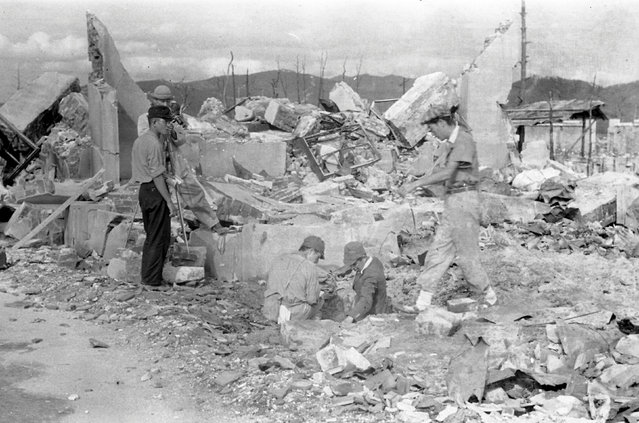
Survey team members measure residual radiation in the ruins of Shima Hospital, located at the hypocenter of the atomic bombing of Hiroshima on August 6, 1945, as Japan Film Corporation staff film them in Saiku-machi district in Hiroshima, Japan, in this handout photo taken by Shigeo Hayashi in October 1945 and released by the Hiroshima Peace Memorial Museum. (Photo by Shigeo Hayashi/Reuters/Hiroshima Peace Memorial Museum)
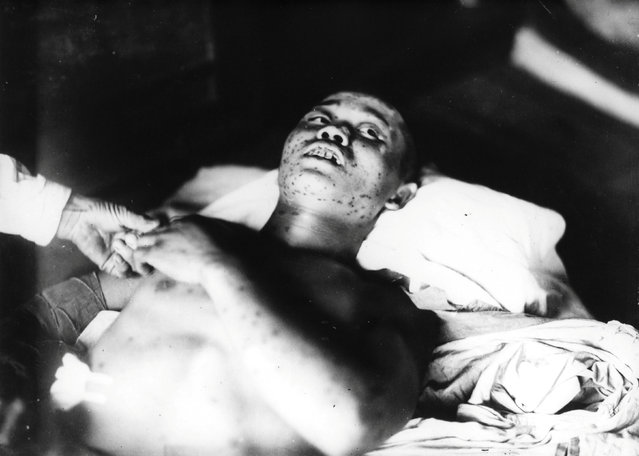
A 21-year-old soldier, who was exposed to the atomic bombing of Hiroshima on August 6, 1945, and has purple subcutaneous hemorrhage spots on his body, is treated at the Ujina Branch of the Hiroshima First Army Hospital in Hiroshima prefecture, Japan, in this handout photo taken by Gonichi Kimura on September 3, 1945 and released by the Hiroshima Peace Memorial Museum. (Photo by Gonichi Kimura/Reuters/Hiroshima Peace Memorial Museum)
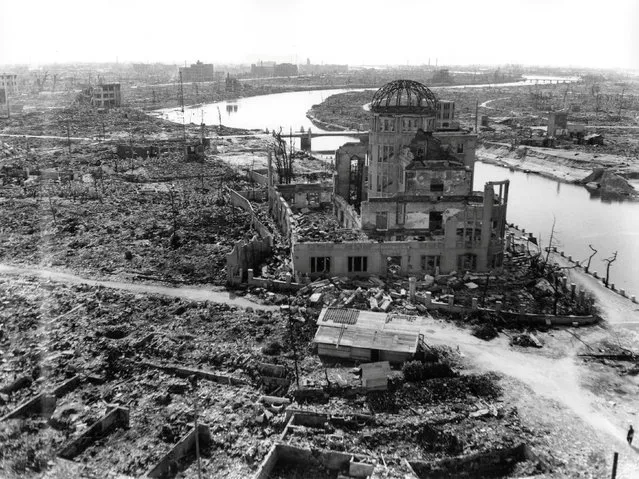
The gutted Hiroshima Prefectural Industrial Promotion Hall, currently known as Atomic Bomb Dome or A-Bomb Dome, is seen after the atomic bombing of Hiroshima, Japan, on August 6, 1945, in this handout photo taken by U.S. Army in November, 1945, and distributed by the Hiroshima Peace Memorial Museum. (Photo by Reuters/U.S. Army/Hiroshima Peace Memorial Museum)
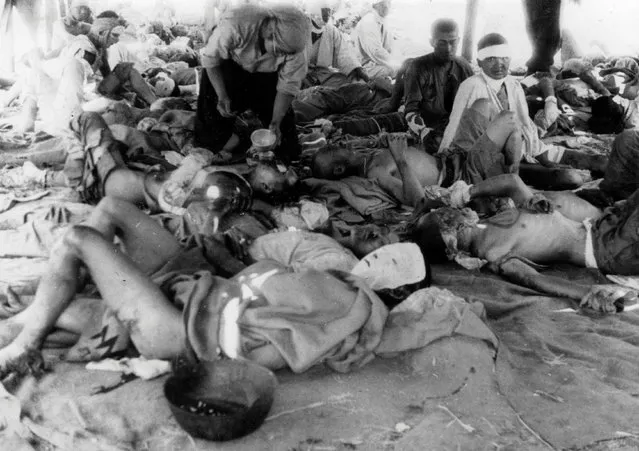
Victims of the atomic bombing of Hiroshima on August 6, 1945 are seen at an emergency relief station in the Otagawa River embankment in Hiroshima, Japan, in this handout photo taken by Yotsugi Kawahara on August 9, 1945 and released by the Hiroshima Peace Memorial Museum. (Photo by Yotsugi Kawahara/Reuters/Hiroshima Peace Memorial Museum)
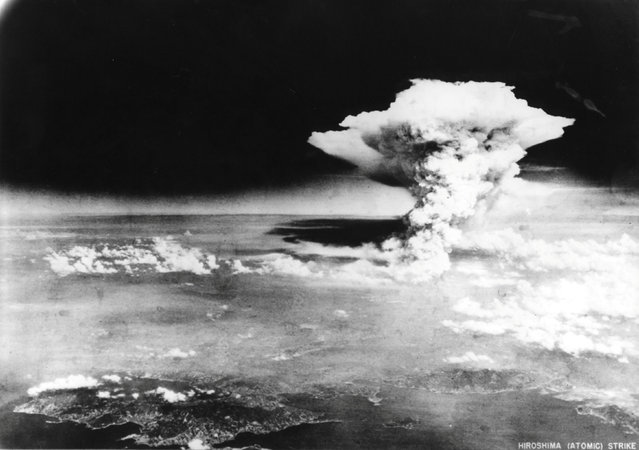
An atomic cloud billows, following the explosion of the first atomic bomb to be used in warfare in Hiroshima, Japan, in this handout photo taken by U.A. Army on August 6, 1945, and distributed by the Hiroshima Peace Memorial Museum. The word written on the photo are from source. (Photo by Reuters/U.S. Army/Hiroshima Peace Memorial Museum)
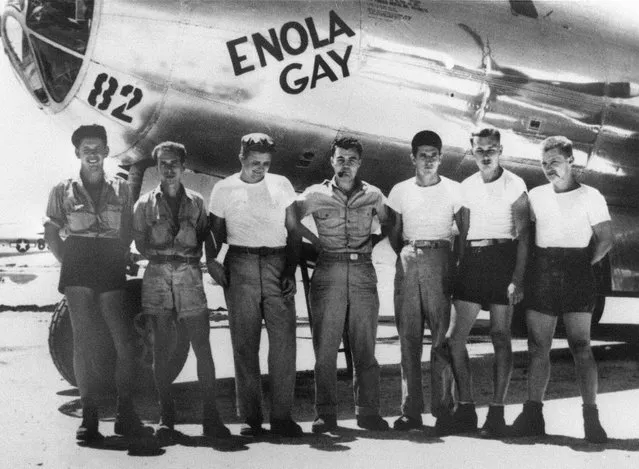
American bomber pilot Paul W. Tibbets Jr. (center) stands with the ground crew of the bomber “Enola Gay” which Tibbets flew in the atomic bombing of Hiroshima, Tinian Island, Northern Marianas, August 1945. Ground crew includes (left to right) engine mechanic Private Harold Olsen, Corporal John Jackson, crew chief Staff Sergeant Walter McCaleb, Tibbets, engine mechanic Sergeant Leonard Markley, engine mechanic Sergeant Jean Cooper, engine mechanic Private John Lesnieski. About 120,000 people were killed outright by just one atomic bomb (called “Little Man”) and nearly a quarter million over time from injuries and radiation effects. (Photo by AP Photo)
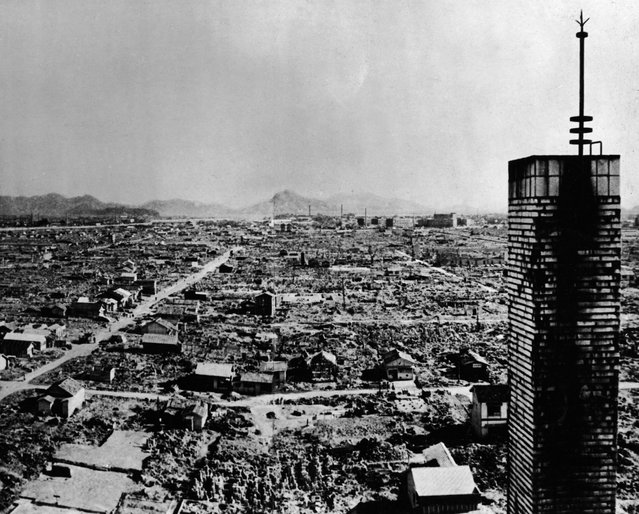
High-angle view of a section of the city of Hiroshima after the US atomic bombing on August 6, 1945. (Photo by Keystone/Getty Images)
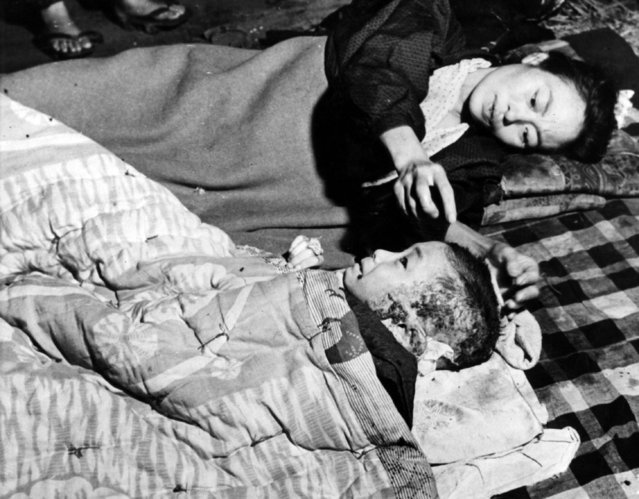
A mother tends her injured child, a victim of the atomic bomb blast at Hiroshima. (Photo by Keystone/Getty Images)
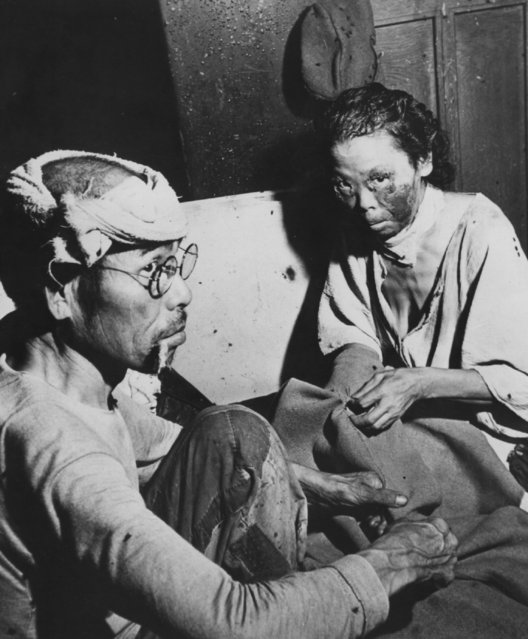
Victims of the atomic blast sit in a makeshift hospital in a damaged bank building in the centre of Hiroshima. (Photo by Keystone/Getty Images)

A victim of the atomic bombing of Hiroshima. (Photo by Keystone/Getty Images)
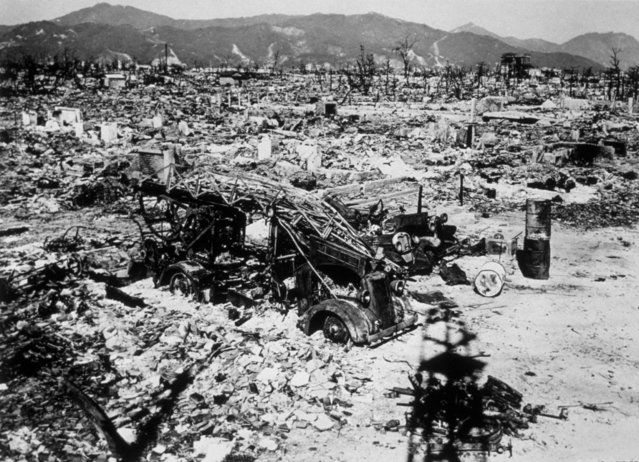
Atomic bomb damage at Hiroshima with a burnt out fire engine amidst the rubble, 1945. (Photo by Keystone/Getty Images)

The B-29 bomber “Enola Gay” in Japan, after bombing Hiroshima, 1945. (Photo by Keystone/Getty Images)

A victim of the American atomic bombing of Hiroshima, Japan, shows the burns on his arms, circa 1947. (Photo by Keystone/Getty Images)
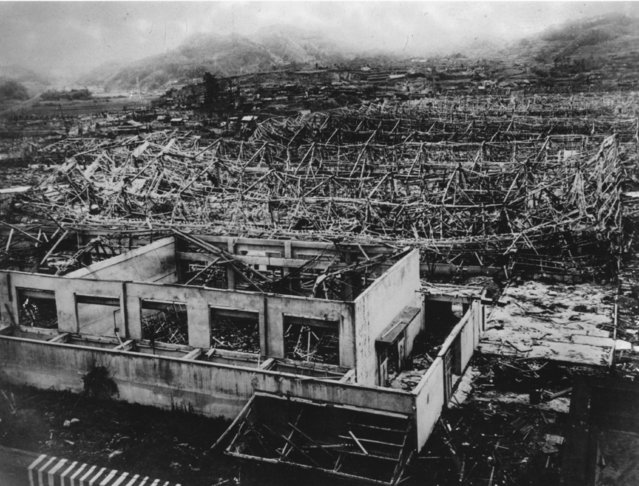
Wreckage of buildings in Hiroshima after the dropping of the atomic bomb, August 1945. (Photo by Keystone/Getty Images)
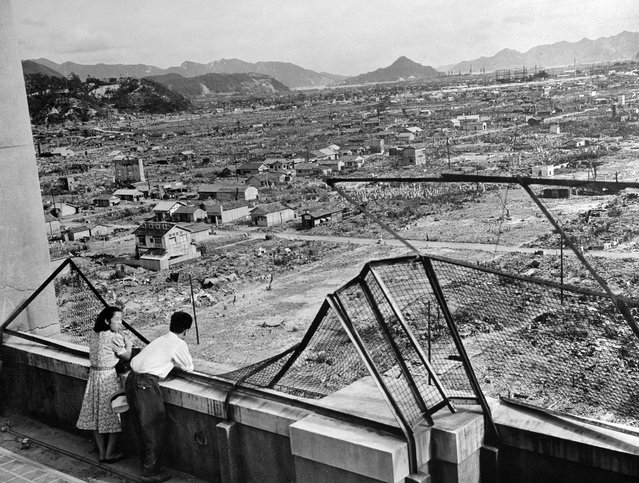
This file photo dated 1948 shows the devastated city of Hiroshima some three years after the US dropped an atomic bomb on the city, 06 August 1945, at the end of World War II. (Photo by AFP Photo)
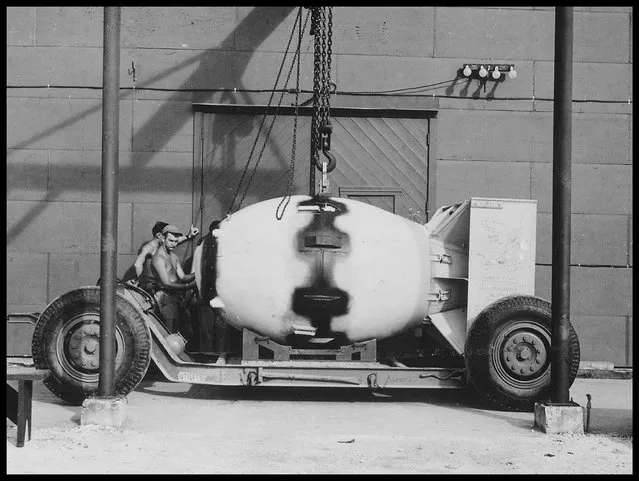
“Fat Man” on transport carriage, Tinian Island, 1945. “Fat Man” was the codename for the type of atomic bomb that was detonated over the Japanese city of Nagasaki by the United States on 9 August 1945. (Photo by Universal History Archive/UIG via Getty Images)
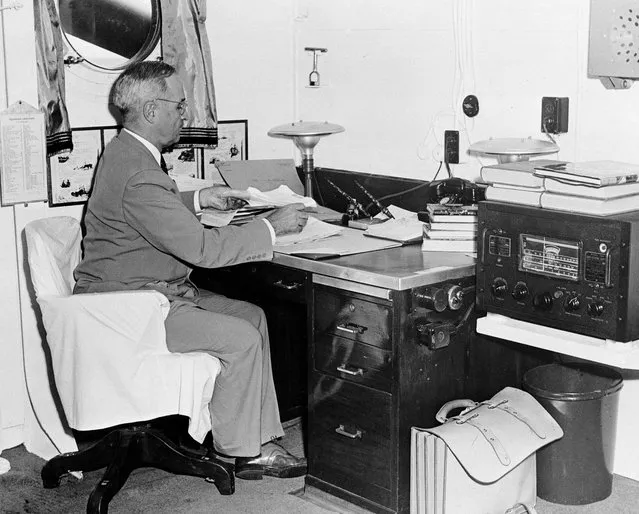
In this August 6, 1945, file photo, aboard the cruiser Augusta, President Harry S. Truman, with a radio at hand, reads reports of the first atomic bomb raid on Japan, while en route home from the Potsdam conference. On two days in August 1945, U.S. planes dropped two atomic bombs, one on Hiroshima, one on Nagasaki, the first and only time nuclear weapons have been used. Their destructive power was unprecedented, incinerating buildings and people, and leaving lifelong scars on survivors, not just physical but also psychological, and on the cities themselves. Days later, World War II was over. (Photo by AP Photo)
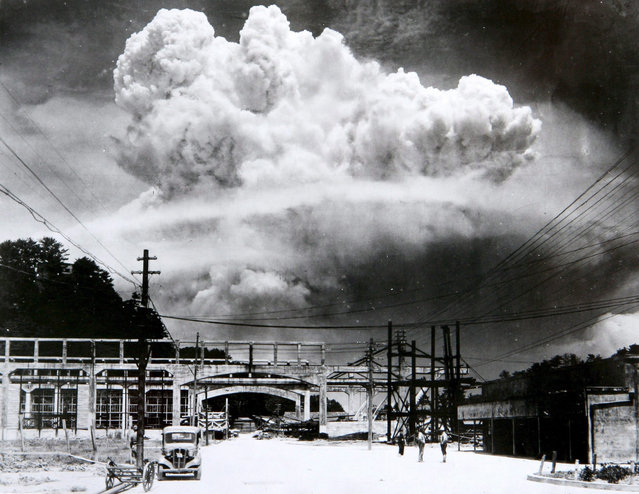
The nuclear bombing of Nagasaki, Japan, 9th August 1945 during world war two. (Photo by: Universal History Archive/UIG via Getty Images)

A mushroom cloud rises moments after the atomic bomb was dropped on Nagasaki, Japan, August 9, 1945. (Photo by AP Photo)
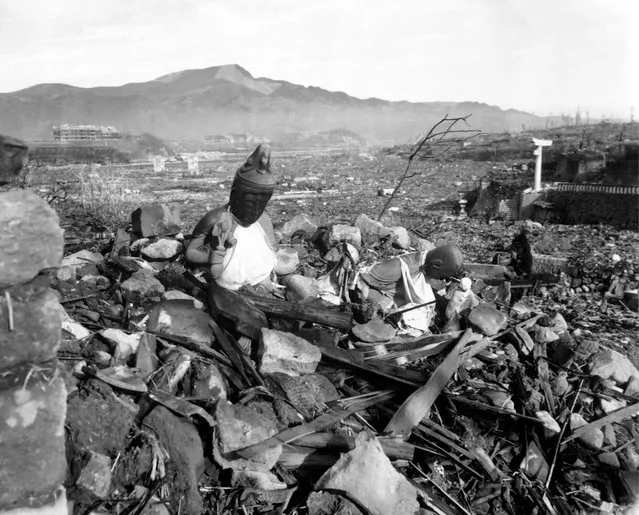
Photograph of a destroyed Nagasaki Temple after the atomic bombing of Hiroshima and Nagasaki. Dated 1945. (Photo by Universal History Archive/UIG via Getty Images)
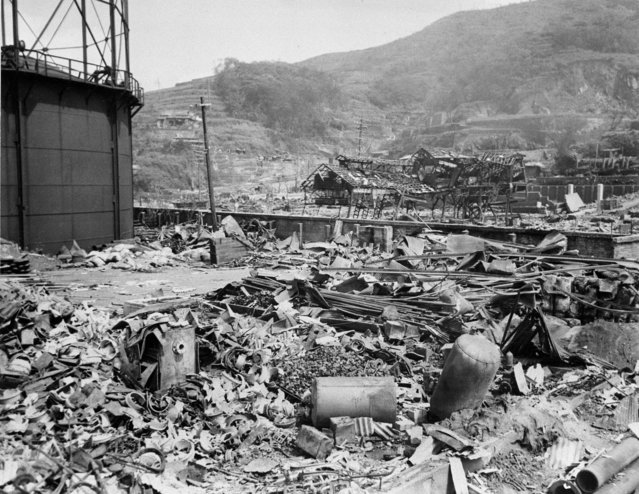
One storage tank is all that remains upright on the site of the Nagasaki gas works. Drums are scattered amid the debris in the foreground. (Photo by . (Photo by AP Photo)/AP Photo/ACME Pool)
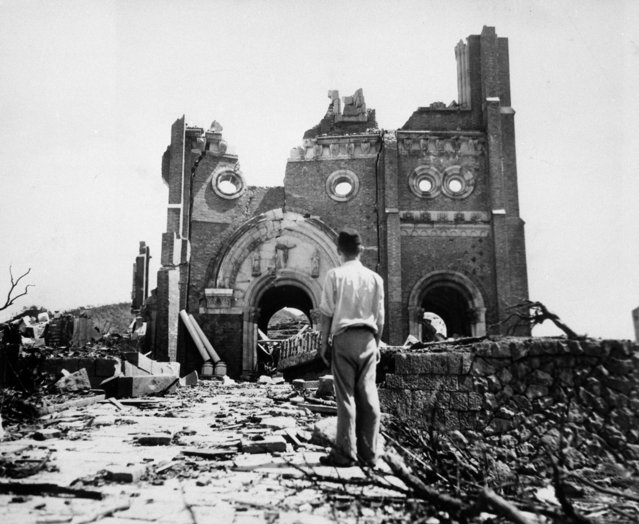
The Urakami Catholic Cathedral in Nagasaki, seen September 13, 1945, is laid waste in the aftermath of the detonation of the atom bomb over a month ago over this city. (Photo by Stanley Troutman/AP Photo/ACME)
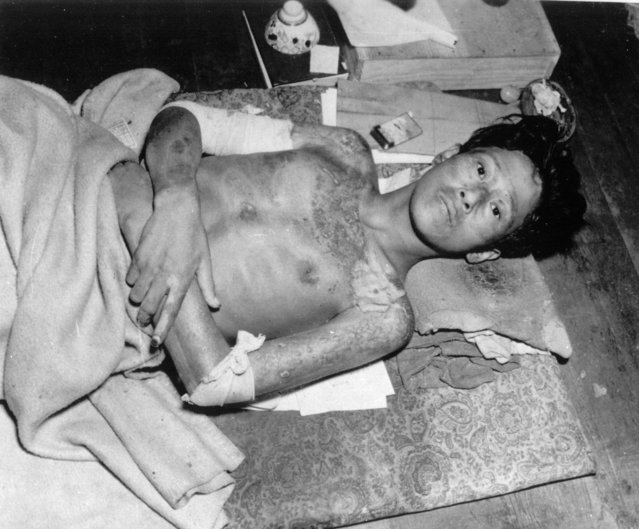
This young man, a victim of the second atomic bomb ever used in warfare, is seen as he is lying sick on a mat, in Nagasaki, in late 1945. The bombing killed more than 70,000 people instantly, with ten thousands dying later from effects of the radioactive fallout. (Photo by AP Photo)
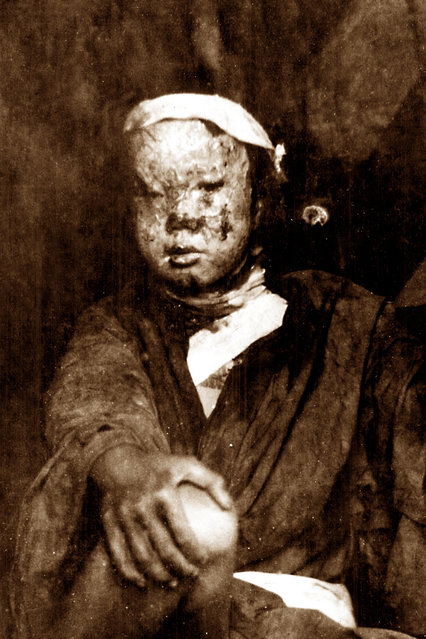
Child casualty of the nuclear bomb at Nagasaki, Japan, August 1945. (Photo by: Universal History Archive/UIG via Getty Images)

This August 6, 1945 file photo, shows the destruction from the explosion of an atomic bomb in Hiroshima, Japan. The 70th anniversary of the atomic bombings of Hiroshima and Nagasaki are being marked with memorial services, peace concerts and art exhibits. More than 200,000 people died in the two blasts, which were the first wartime uses of nuclear weapons and which led to Japan’s surrender and the end of World War II. (Photo by AP Photo)
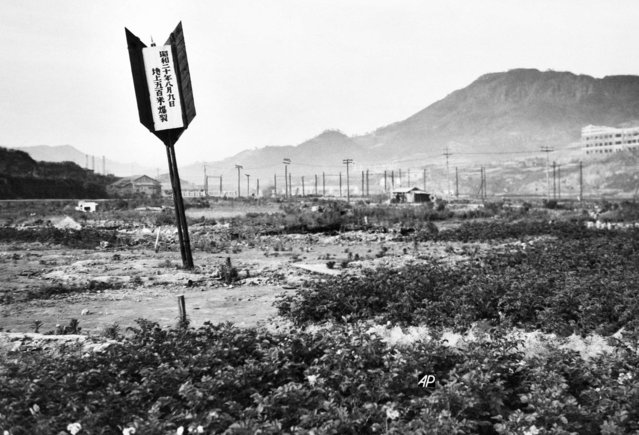
Arrow marks the spot where the A-bomb struck at Nagasaki, Japan, August 10, 1945. Much of the bombed area is still desolate, the trees on the hills in the background remained charred and dwarfed from the blast and little reconstruction, except of wooden shacks as homes, has taken place. (Photo by AP Photo)

An atomic bomb victim reveals her wounds. Photograph, Hiroshima or Nagasaki, Japan, 1945. (Photo by Ullstein Bild/Ullstein Bild via Getty Images)
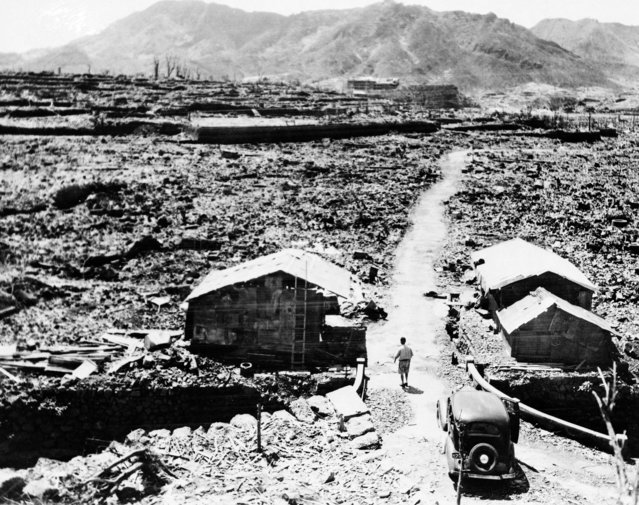
These shacks, seen September 14, 1945, were made from scraps of debris from buildings that were leveled in the aftermath of the atomic bomb that was dropped over Nagasaki. (Photo by AP Photo)
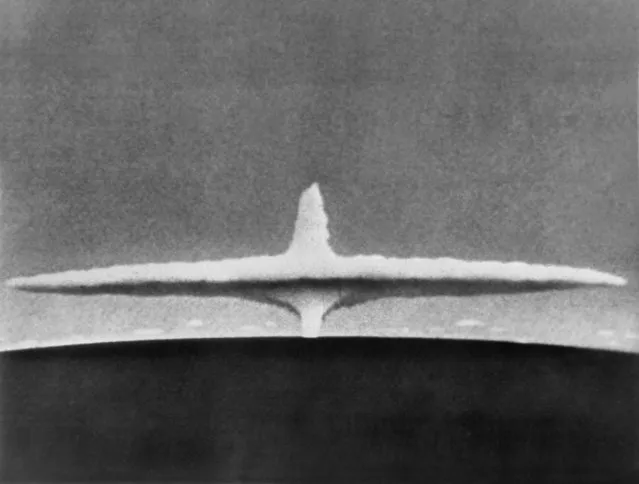
This file photo taken on November 1, 1952 from Majuro Atol shows the explosion of the US's first H-bomb at Enewetak Atoll, in the Marshall Islands. As the Marshall Islands awaits an international court ruling on October 5, 2016 on whether its lawsuit against three nuclear powers can proceed, many in the western Pacific nation question the merit of the David-versus-Goliath legal battle. (Photo by AFP Photo/Stringer)

A man pushes a loaded bicycle down a cleared path in a flattened area of Nagasaki, September 13, 1945, following the August 9 nuclear attack by an American B-29. (Photo by Stanley Troutman/AP Photo/ACME)

In this September 4, 1945 file photo, the remains of a factory are seen, upper left, in the southern Japanese city of Nagasaki, gutted by the Aug. 9 atomic bombing. On two days in August 1945, U.S. planes dropped two atomic bombs, one on Hiroshima, one on Nagasaki, the first and only time nuclear weapons have been used. Their destructive power was unprecedented, incinerating buildings and people, and leaving lifelong scars on survivors, not just physical but also psychological, and on the cities themselves. Days later, World War II was over. (Photo by AP Photo)
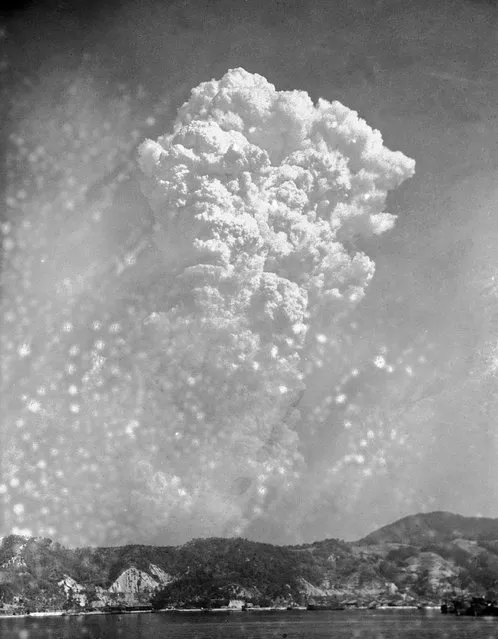
In this August 6, 1945, file photo, smoke rises 20,000 feet above Hiroshima, Japan, after the first atomic bomb was dropped. On two days in August 1945, U.S. planes dropped two atomic bombs, one on Hiroshima, one on Nagasaki, the first and only time nuclear weapons have been used. Their destructive power was unprecedented, incinerating buildings and people, and leaving lifelong scars on survivors, not just physical but also psychological, and on the cities themselves. Days later, World War II was over. (Photo by AP Photo)

In this August 6, 1945, file photo, shortly after the first atomic bomb ever used in warfare was dropped by the United States over the Japanese city of Hiroshima, survivors are seen as they receive emergency treatment by military medics. (Photo by AP Photo)
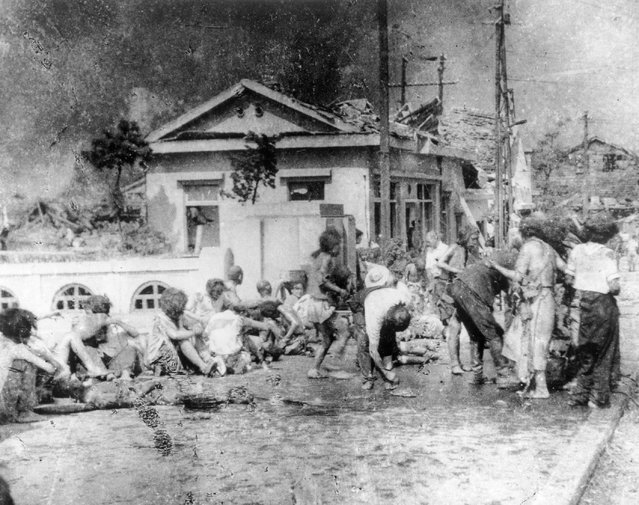
In this August 6, 1945, file photo, survivors of the first atomic bomb ever used in warfare are seen as they await emergency medical treatment in Hiroshima, Japan. The explosion instantly killed more than 60,000 people, with ten of thousands others dying later from effects of the radioactive fallout. (Photo by AP Photo)

A huge mushroom cloud rises above Bikini atoll in the Marshall Islands July 25, 1946 following an atomic test blast, part of the U.S. military's “Operation Crossroads”. The dark spots in foreground are ships that were placed near the blast site to test what an atom bomb would do to a fleet of warships. (Photo by AP Photo)

A 1971 photo of a nuclear bomb detonated at the Mururoa atoll, French Polynesia. President Jacques Chirac announced Tuesday June 13, 1995 that France would resume nuclear testing to verify the safety of existing weapons while advancing toward simulation technology. Eight nuclear tests were scheduled between September and May before France signs a treaty banning all tests. (Photo by AP Photo)
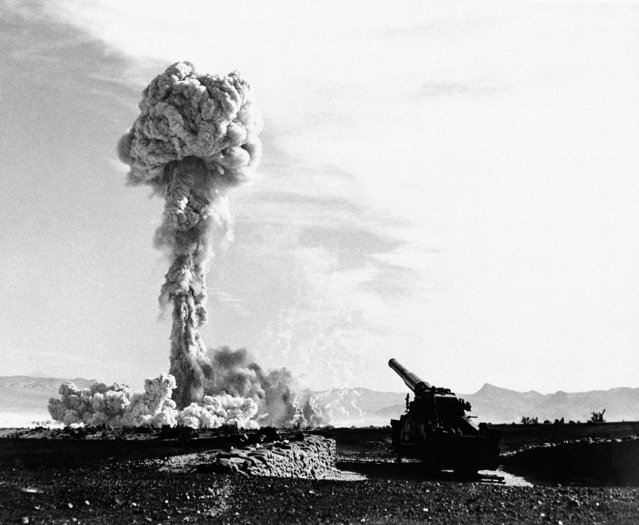
The towering lacy mushroom from the atomic cannon's first test rises from desert floor at Frenchman's flat, near Las Vegas, Nevada on May 25, 1953. The 280-mm gun which tossed the shell to its destination six or seven mile away is in the foreground. The rifle was touched off electrically, with the gun-loading crew entrenched a safe distance away. This picture, released on May 27, by the air force, was made probably about 10 seconds after the explosion. (Photo by AP Photo)
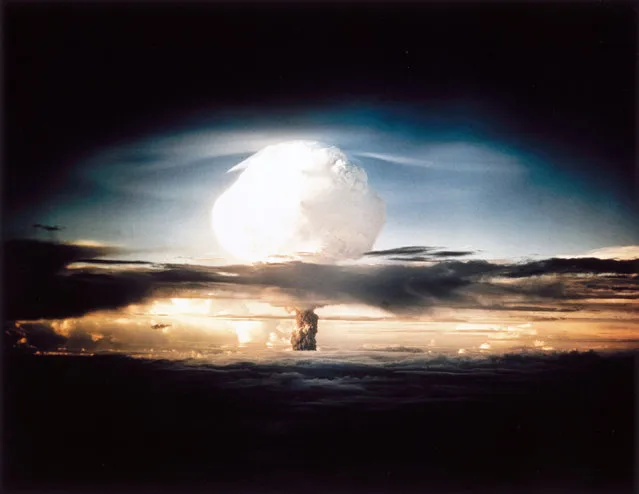
The mushroom cloud produced by the first explosion by the Americans of a hydrogen bomb at Eniwetok Atoll in the South Pacific. Known as Operation Ivy, this test represented a major step forwards in terms of the destructive power achievable with atomic weapons. The hydrogen, or fusion, bomb used a fission device similar to those dropped on Hiroshima and Nagasaki at the end of World War II, detonated inside a container containing deuterium. The high temperatures involved set off a fusion reaction in the deterium, releasing vast amounts of energy. The yield of the weapon was 10.4 megatonnes, more than the total of all the high explosive detonated in the entire duration of the Second World War. (Photo by SSPL/Getty Images)
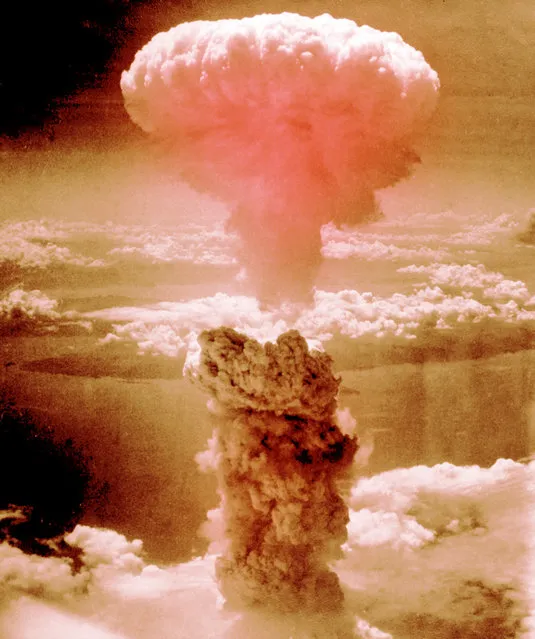
Atomic bomb explosion over Nagasaki, Japan, 9 August 1945. (Photo by Getty Images/Kallista Images)
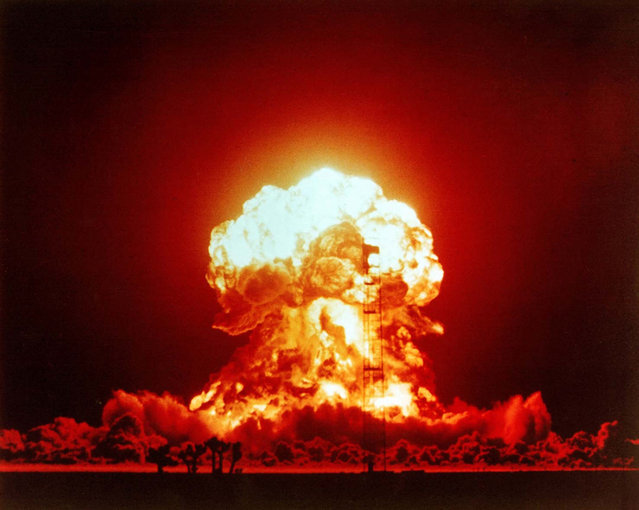
The BADGER shot was a 23 kiloton nuclear bomb. Over 2,000 US soldiers were within 3.7 kilometers of the explosion. (Photo by Alamy Stock Photo)
12 Aug 2017 05:38:00,
post received
0 comments
